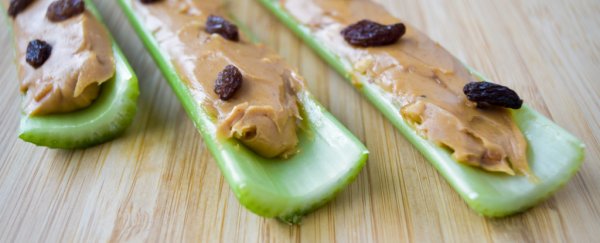The internet is full of quick-fix weight-loss hacks. One popular suggestion is to eat 'negative-calorie' foods such as celery, because you burn more energy eating and digesting the celery than you absorb.
Is it true that eating some foods makes us lose calories rather than gain them? And does eating these foods help weight loss? We asked three experts in nutrition and physiology: 'Do negative-calorie foods exist?'; here is what we found.
What are calories and what are they for?
Louise Dunford, an expert in nutrition and physiology from De Montfort University in the UK, explains that "a calorie is a unit of energy, usually expressed as kilocalories (kcal) for the energy content in food".
Most food packaging comes with labels that describe how many calories are in that product. We consume calories by eating and use calories by burning energy.
Dunford says: "Our energy needs are made up of three components:
-
The energy needed to maintain a body at rest, which is the energy needed for our body to carry out its basic processes so we can live.
-
The thermic effect of eating, which is the increase in metabolic rate after eating, while food is digested and absorbed.
-
Additional energy needed for activity and exercise."
What are 'negative-calorie' foods?
"The theory behind negative calorie foods is that some foods have lower calorie (energy) content than the amount of energy it takes to digest and absorb the food into the body," Dunford says.
"This sounds plausible, in theory. But in reality, even the lowest calorie foods, such as celery, contain more calories than it takes to break down and absorb them in the body."
Some foods that have been labelled as 'negative-calorie' include celery, grapefruit, tomatoes, cucumber, broccoli, lettuce and carrots.
What is the evidence that 'negative-calorie' foods exist?
Two of the three experts said there was no evidence that negative-calorie foods exist.
"Even the humble stick of celery, while being about 95 percent water, still contains a small number of kilojoules from carbohydrate (65 kJ to be exact)," says Tim Crowe, an expert in nutrition from Thinking Nutrition.
"Though there is an energy cost to your body in digesting food, called the thermic effect of food, but that equates to about 10 percent of the energy in the food. So even celery adds some kilojoules to your diet. And while it's a small number, it's definitely not a negative number."
Although not a food, cold water has been considered calorie negative. Cornelie Nienaber-Rousseau, an expert in nutrition from North-West University in South Africa, says: "Water contains no energy and when drinking water outside body temperature ranges will expend some energy to maintain the body's internal temperature i.e. the so called water-induced thermogenesis effect."
Several studies have tried to investigate whether this effect could be beneficial for weight loss, but most found no or minimal calorie expenditure after drinking cold water.
Chewing gum – although something which we may not consider food – has also been considered 'negative-calorie'.
Again, however, its effect is minimal, Nienaber-Rousseau says: "Mastication merely burns 11 kcal (46.2 kJ) per hour and can therefore hardly be considered as being real exercise. Because one stick of gum contains around 10 kcal (42.0 kJ), it will require being chewed for one or more hours to burn the energy the gum provides."
Do so-called 'negative-calorie foods' offer any benefits?
If celery, grapefruit and cucumber do not cause us to lose calories, how come they are often found in effective weight-loss diets?
"Diets based on so-called negative-calorie food or to use the more acceptable term 'free foods' do not work because they cause an energy deficit, but rather because these foods satisfy hunger by filling the stomach with food that is not energy dense and coupled with exercise can lead to burning more fuel than was ingested to create an overall energy deficit," Nienaber-Rousseau says.
Or, as Crowe puts it: "How foods like celery, lettuce and broccoli can help you lose weight is if your mouth is full of celery, then there's no room to fit in burgers and fries."
Eating so-called 'negative-calorie' foods can therefore aid weight loss by making you feel full. However, it is important not to just add them into your diet.
"It's important to replace higher calorie items on a plate rather than add these fruit and vegetables to meals, as by simply adding healthy items you increase the overall calorie content. For example, a cheeseburger plus a salad contains more calories than a cheeseburger alone," Dunford says.
Interestingly, this can be psychologically difficult to do – Nienaber-Rousseau notes "studies indicate that people would underestimate the energy content of a food/meal when a healthy food such as a free food is present – this phenomenon [is known] as the 'negative calorie illusion"'.
"Unfortunately, negative calorie foods are a myth, and there is no easy way to lose weight and keep it off in the long run," Dunford summarizes.
"Changing your food and drink options for healthier ones on a permanent basis is more likely to lead to sustained long-term weight loss than short-term dieting alone."
Article based on 3 expert answers to this question: Do negative-calorie foods exist?
This expert response was published in partnership with independent fact-checking platform Metafact.io. Subscribe to their weekly newsletter here.
